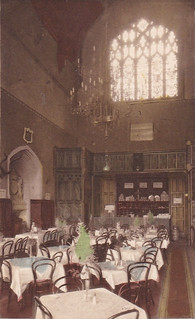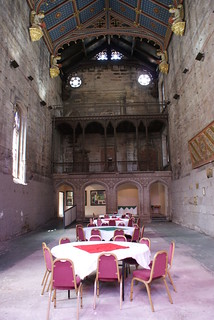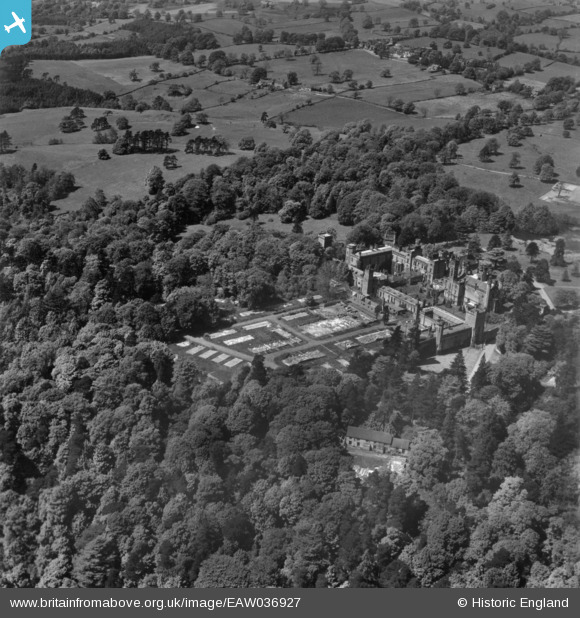During World War Two, it is well known that Alton Towers was requisitioned to become an army camp and was occupied by several Officer Cadet Training Units (OCTUs).
Not much is documented about life at Alton Towers during the war years, for obvious reasons. But as the years pass and more archives and records from the period are made available it is possible to piece together a picture of what life around camp was like, as well as the experience of the recruits, who as it turned out would be the final occupants of Alton Towers, following in the footsteps of the Earl’s of Shrewsbury.
Early War Years
The start of World War Two initially seems to have had little impact on day-to-day life at Alton Towers. An article in the Architectural Review in May 1940 suggests that in the early days of the war, Alton Towers continued to operate as a visitor attraction and the house was still open to the public at that point, even if visitor numbers were low.
It would seem that the house was requisitioned at some point in the second half of 1940 and opened as an Army Training Centre early in the following year. On 15 January 1941, the Alton Towers Chapel was reported as having been renovated and reconsecrated for ‘the use of troops passing through the district‘, which likely coincided with the base opening.
It seems that the first unit to arrive at Alton Towers was the 121 Royal Artillery Officer Cadet Training Unit, which was established at Aldershot and moved to Alton Towers in 1941.
They were later joined by the 160 Machine Gun OCTU in 1943 and later the 163 OCTU that was formed during the Second World War from the Artists Rifles.
Of these units, the only visible indication of their time at Alton Towers is a memorial to the 160 Machine Gun OCTU, which can be found on a tower near the entrance to Hex. This plaque was erected by The Military Historical Society in 1974, and whilst it does not indicate the exact dates that the 160 Unit was active at Alton Towers, it does list the Machine Gun Regiments in which the Officer Cadets went on to serve.
The plaque is headed by CLX, the Roman numerals for 160, and closes with a quote from Virgil’s Aenead, musing on the remembrance of past trials. The quote reads:
FORSAN ET HAEC OLIM MEMINISSE IUVABIT
which translates to
Perhaps one day it will be pleasant to remember even this.
Alton Towers as an OCTU
The army camp centred around the house, with additional complexes built both in front and behind Alton Towers.
The main army complex was built on the former kitchen gardens behind the Towers, where the World of David Walliams exists today. The Kitchen Gardens had been cleared in the 1920s when Alton Towers had first reopened as a visitor attraction, but the layout had broadly been retained. So a complex of huts were laid out on the former beds, between the existing pathways.
This area housed numerous individual huts, around a large central building. Based on aerial photography taken in later years, it appears most of the huts were made of concrete with steel roofs, but as the camp spread out towards the Flag Tower, the buildings transitioned to become corrugated Anderson huts.
Across the lake from the main house, a secondary army complex was built on the front lawns, which took up a similar footprint of the modern-day event area, where it is now more common for crowds to enjoy Oktoberfest and Scarefest, or watch the annual Fireworks. At the time, that part of the park was all grassland, with a road running through it, roughly where the path from CBeebies Land to Mutiny Bay crosses the foot of Towers Street today. A large square area of the lawn was cleared between this road and the lake, providing a complex that contained at least two large brick barrack buildings, as well as the camp’s medical facilities. No doubt this complex would have included other associated service huts as well.
Next door the former Stables in the Courtyard, which is now at the heart of Mutiny Bay, housed senior officers and was also part of a complex that included the machine shops and military vehicle storage. Beyond this the open fields, where Katanga Canyon and the Coach Parks are today, would have been used for training and housed one of the camps assault courses.
Soldiers at Alton TowersA group of soldiers, likely of the 163 Officer Training Corps Unit, photographed in the Courtyard at Alton Towers in May 1944.View Full Resource on Staffordshire Past Track
However, the camp’s main assault course was located in the Deer Park, where the majority of the field training took place. Today the Deer Park is where the Car Parks and hotels can be found, but until as recently as the 1980s this part of the resort was rolling fields, split up by occasional copses of trees. The landscape, which was also littered with multiple abandoned farm buildings, offered the perfect setting for a variety of different exercises, including tank and artillery training.
The army also made full use of the estate’s natural features. The steep slopes of the valleys, covered in rhododendrons, acted as a substitute for jungle landscapes during training exercises, whilst the uphill endurance of the Step walk was ideal for warm-ups. The water features of the estate were also used: the Churnet was used for river crossings, whilst amphibious vehicle training occurred on the Boating Lake.
At the side of Alton Towers, the plaza neighbouring the Grand Entrance played host to the camp’s Parade Ground, offering quite a dramatic backdrop for the pomp and grandeur of military parades. Today this area is Fountain Square, where the entrance to Hex resides.

Source: Staffordshire Past Track
It seems that the Gardens, including the lawns directly in front of the Towers, were largely left undisturbed by the army occupation, and it is well known that a small team of gardeners were retained during the war to carry out at least essential maintenance in the valley. It is not clear how much access residents of the army camp had to the gardens, or whether they were out of bounds to the troops.
However, the Swiss Cottage did remain open during the war. But where once it had been offering tea and refreshments for day guests to the park, it now served soldiers, who were looking for alternative refreshments away from the camp catering.
The House

Today we know Alton Towers as a ruin and almost hauntingly quiet at the best of times. It is therefore easy to slip into the belief that, whilst an army camp sprung up in the grounds, the mansion itself was ‘sealed up’ for the duration of the war, other than certain rooms that had specific uses. This assumption has been oft repeated in official guides across the years, as well as in books such as Michael Fisher’s Alton Towers Past & Present.
But this couldn’t be further from the truth, and sources from the time suggest the exact opposite. From food preparation and service in the basement, right through to rooftop patrols and a lookout position in the Leicester Tower, during the war period almost every piece of the house was in use. Arguably at this time the house was at the busiest it has ever been, with entire battalions of soldiers living within its walls, alongside their superior officers, whilst the lower floors hummed with activity of the Auxiliary Territorial Service, who were tasked with the day-to-day operation of the camp.
Evidence of the time makes it clear how some of the house was used during the war, but even where no contemporary accounts exists, it is possible to make an educated guess as to how other rooms were used.
The house was divided between areas which would have been open to all personnel within the camp, such as the Chapel, which had been reconsecrated to serve all the residents of the camp. Other areas, however seemed to be more restricted, depending on usage.
 The South Range of the house was used for operational purposes, including the Talbot Gallery, which was converted into an indoor Firing Range, resulting in a reconfiguration that is still visible today. As a gallery, originally the room was lit mainly by skylights, but the army punched square ‘windows‘ into the walls. These modifications were a rare example of a permanent change made by the army, and you can see these additional ‘windows’ today when you look back at the Gallery on exiting Hex.
The South Range of the house was used for operational purposes, including the Talbot Gallery, which was converted into an indoor Firing Range, resulting in a reconfiguration that is still visible today. As a gallery, originally the room was lit mainly by skylights, but the army punched square ‘windows‘ into the walls. These modifications were a rare example of a permanent change made by the army, and you can see these additional ‘windows’ today when you look back at the Gallery on exiting Hex.
Next door, the Octagon acted as a Guard Post, whilst the Armoury, which had only ever been used for decorative displays of weaponry, for the first time matched its title, acting as the storehouse for guns and munitions.
The rest of the house seemed to be mainly used for accommodation and social purposes. Accounts from the time confirm that most of the areas of the house that had acted as dining rooms and catering facilities prior to the war became social spaces used by more senior recruits for both official purposes as well as downtime. The libraries became common rooms, whilst the neighbouring Music Room acted as a bar for official celebrations, no doubt reusing fixtures and fittings from the pre-war years.
 As was common during the war, many of the more grand fire places throughout the building were partially bricked up to make them more fuel efficient. This included the fireplaces in the Banqueting Hall, and whilst there is scant evidence for how the room was used at the time, we know it was in use and it would seem a logical conclusion to assume that this most grand of rooms, which still retained its wood panelling at the time, likely acted as the officers’ mess for the most senior staff within the camp.
As was common during the war, many of the more grand fire places throughout the building were partially bricked up to make them more fuel efficient. This included the fireplaces in the Banqueting Hall, and whilst there is scant evidence for how the room was used at the time, we know it was in use and it would seem a logical conclusion to assume that this most grand of rooms, which still retained its wood panelling at the time, likely acted as the officers’ mess for the most senior staff within the camp.
Upstairs, the bedrooms that once housed the Earls, their families and guests, once again became sleeping quarters, but now used by the camp’s commanding officers, as well as the more senior Officer Cadets. There is evidence of both the East and West Wings of the house being used to accommodate troops, as well as the Pugin Rooms over the central portion of the house. Whilst the smaller rooms were likely used by the senior officers running the camp, some of the larger suites of rooms were shared between entire squads of men, with standard army cots filling the spaces once adorned with the Earl’s opulent beds and furniture.
During these years the house was home to hundreds of people and would have been a hive of constant activity; and a far cry from the almost leisurely days when a single family and their servants lived in the property.
Life in the Camp
121st Officer Training Corps Unit, Alton TowersGroup photograph of Officer Cadets and Officers in Charge of No.53 Squad ‘B’ Battery, 121st Officer Training Corps Unit, R.A. (H.A.C.). they were based at Alton Towers. Photographer: Gerald McCann …View Full Resource on Staffordshire Past Track
Accounts of life in camp from the early period of occupation present an atmosphere that was generally genial, and relatively informal for a military facility. It was not uncommon for recruits to mix with the permanent staff and even senior officers, possibly due to the nature of the training. The camp was training Officer Cadets, so it would make sense that there would be additional opportunities to interact with senior officers, especially as recruits entered the final stages of their training in preparation for passing out.
The standard training period at Alton Towers was around 6 months. Most recruits would arrive by train and their first impressions of Alton Towers was an uphill slog from the train station to the camp via the Step Walk.
Once they had reached the camp, it was normal for new residents to initially occupy the somewhat cramped and basic huts that were built in the grounds of Alton Towers. Accounts from the time suggest that it was not out of the ordinary for recruits to move billets several times whilst at the camp, moving into gradually better accommodation as their training progressed, and the recruits gained seniority within the military.
 The hastily-constructed huts were a far cry from the quality of accommodation that became available as troops advanced through their training, including the potential to move into the mansion itself. Many of the grandest bedrooms within the house were spacious enough that they could act as a billet for a full squad of men, offering the residents some of the perks once enjoyed by the Earls themselves, such as private dining rooms, as well as direct access onto the Chapel balcony for church services.
The hastily-constructed huts were a far cry from the quality of accommodation that became available as troops advanced through their training, including the potential to move into the mansion itself. Many of the grandest bedrooms within the house were spacious enough that they could act as a billet for a full squad of men, offering the residents some of the perks once enjoyed by the Earls themselves, such as private dining rooms, as well as direct access onto the Chapel balcony for church services.
It seems that as the camp filled up over the years, conditions somewhat deteriorated, with later recruits offering less than glowing reviews of the camp. One recruit in 1945 wrote: “Our billets were extremely crowded. The food was poor and the NAAFI canteen inadequate for the size of the camp. Up to a 2 hour Queue at night and then little left.”
Whilst it might have been cramped in the later years, the OCTU at Alton Towers was generally a safe place during the war, and most recruits passed through without incident (even if not all of them made the cut and were returned to their original units). But military training does not come without risks, and the camp was not without incident. As noted by research carried out on behalf of the Bury Grammar School Alumni, one such incident resulted in the death of 19-year-old Officer Cadet Edward Nash Reynolds, Royal Armoured Corps. In an accident that likely took place in the Deer Park at Alton Towers, ‘Josh’ Reynolds was commanding a tank during a night exercise which overturned, resulting in his death and subsequent burial in nearby Cheadle Cemetery.
During the war the recruits became part of local life in Alton and were not restricted to the camp, often enjoying the drinking establishments and other amenities in the local villages, as well as further afield. The train line neighbouring Alton Towers was still in use at the time, with direct access from the camp. This meant that soldiers were easily able to visit neighbouring towns on days off from training, as well as for nights out, and were welcomed by many locals, but not universally.
After six months of training, the Music Room in the house would host official parties to mark the Passing Out and the end of the Officer Cadets’ stay at Alton Towers. At times such as these, the mansion would no doubt have been transported back to an earlier time of peacetime revelry. But for some of the troops who would have celebrated within Alton Towers, this would have marked one final night out, before swapping the relative safety of the Staffordshire Moorlands for frontlines around the world.
The young men who passed through the camp were often not there by choice, but out of a sense of duty to their country, no doubt leaving them with a very different impression of their time at Alton Towers. Some had more fond memories than others, but for almost all of the men who passed through Alton Towers during the war, their experiences of the camp would have been a far cry from what awaited them next, as they entered active duty.
After the War
The army were in occupation at the camp until at least 1947 and contrary to popular wisdom, Alton Towers was not completely off limits to the public for the duration of this time. After the war, the army occasionally hosted open days and Alton Towers first re-opened to the general public in 1946.
The Gardens were open on June 8th, 9th, and 10th 1946 from 11 a.m. to 8 pm with 3,700 people in attendance. These open days ran using a similar format to how guests experienced Alton Towers when it fully reopened to the public in 1952. The Gardens were now the main attraction, housing stalls and refreshments throughout, but with the house off limits as part of the army camp. The proceeds from the open days went to the Army Benevolent Fund, raising a sum of £386 18s 6D (equivalent to around £13,800 today).
The army opened the park to the public at least three times during the post-war years. The second time was on August 4th-6th 1946, attracting some 5,000 visitors, with £570 raised(£20,000). In 1947, the Gardens were open from May 25th-26th and this would be the last official opening before the army left Alton Towers.
After the war, the camp was used as part of the army’s Demobilisation effort, which returned service personnel to civilian life at the end of their National Service. It served this purpose until June 30th 1947, when the army’s main occupation ended. However, at this time a contingent was left at Alton Towers to maintain the security of the property and guard against occupation by squatters.
Some sources suggest that after this, the Army School of Education at Alton Towers was tasked with training ‘men of higher education‘ to become instructors, effectively becoming an army teacher training unit, producing schoolmasters to provide educational opportunities to troops returning from the frontlines. But if the camp was used in this way, it was a limited engagement, which had ended by April 1948, marking a complete end of the army’s occupation.
 In the later part of 1948, following the departure of the army and its guard unit, there was a rise in vandalism, and local newspapers reported that “hooligans were running loose doing thousands of pounds worth of damage”. Of more concern, there were also reports of theft of lead from the roof of the mansion, which would have rendered parts of the building no longer waterproof.
In the later part of 1948, following the departure of the army and its guard unit, there was a rise in vandalism, and local newspapers reported that “hooligans were running loose doing thousands of pounds worth of damage”. Of more concern, there were also reports of theft of lead from the roof of the mansion, which would have rendered parts of the building no longer waterproof.
The damage caused by such thefts, may explain the water damage documented by the National Monuments Record in photos taken in 1951, shortly before the building was gutted. At this time many of the rooms appeared to be in relatively good condition, but the state of the Octagon’s roof in particular, where the sky is clearly visible through the joints of the roof, supports the notion of damage related to lead-removal.
Negotiations regarding derequisitioning of Alton Towers started in 1948, but it seems that a deal was not reached until 1950. Most of the buildings constructed by the army were demolished in 1949, but many of the foundations and several partially destroyed buildings were still in place when the estate was handed back to its original owners, which seems to have happened in May 1950.
Source: Britain from Above
Alton Towers changed ownership shortly after derequisitioning was complete. The new owners opted to strip the remaining assets from the house, leaving it an inaccessible ruin, but the rest of the park and Gardens reopened to the public in 1952, starting Alton Towers’ next era.
But for a brief period as a military complex, Alton Towers had bustled with life in a completely unique way, and for the final time was home to an entire community, who lived, worked and played within the estate. The towers, which are now synonymous with the thrills and fun of the theme park, would have held very different memories for the young men who passed through Alton Towers on their way to the battlefields of the Second World War. For many who lived in the camp during that time, their experience would have been so far removed from the park we know today that Alton Towers would be more or less unrecognisable to them, if not for the iconic architecture that was the backdrop of their training, just as it is for the theme park today.
Credits:
The contents of this article were informed by research carried out by Bury Grammar School’s Alumni and AltonTowersMemories (website now offline, but can still be found on Youtube), as well as Michael Fisher’s Alton Towers Past and Present. Other sources include Staffordshire Past Track, BBC’s WW2 People’s War and multiple local newspaper archives.
It is also worth noting, this article was not written by a military historian, but a theme park archivist, with a penchant for writing about a certain ruined property in the Staffordshire Moorlands. Apologies for any misuse of military terminology.









